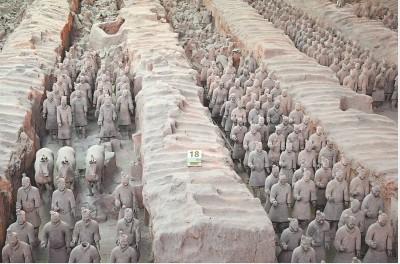
The Terracotta Army: Unveiling the Secrets of Pit 1
A Legion of Clay: The Scale of Pit 1
Terracotta Warriors Pit 1 stands as a testament to the might and ambition of China's First Emperor, Qin Shi Huang. As the largest of the three excavated pits, it offers a breathtaking glimpse into the military prowess of ancient China. This subterranean chamber houses an army frozen in time, a silent legion of over 6,000 terracotta warriors and horses meticulously arranged in battle formation.
An Army's Composition: Infantry, Cavalry, and Chariots
The warriors of Pit 1 are not a homogenous force but represent the diverse branches of the Qin army. The majority are infantrymen, standing stoic and ready for combat, armed with spears, swords, or crossbows. Alongside these foot soldiers stand the cavalry, mounted on their steeds, embodying speed and maneuverability. Completing the military ensemble are the chariots, each pulled by four horses and carrying a driver and a warrior, showcasing the logistical and tactical prowess of the Qin military.
Lifelike and Life-Sized: A Testament to Artistry
What sets the Terracotta Army apart is not just its sheer scale but the astonishing realism of the figures. Each warrior is life-sized, standing between 5'8" and 6'2", and crafted with remarkable attention to detail. Their faces, sculpted with individual expressions and features, reflect a spectrum of ages and emotions. Their hairstyles, armor, and clothing are meticulously rendered, showcasing the diverse roles and ranks within the army. This painstaking artistry not only captures the physical attributes but also hints at the individuality of each soldier, transforming them from mere statues into an army of individuals frozen in time.
A Formation for Eternity: Military Tactics and Strategy
The arrangement of the warriors in Pit 1 is not random but reflects actual military formations of the Qin dynasty. The vanguard, composed of archers and crossbowmen, stands at the eastern end, ready to unleash a volley of arrows upon any approaching enemy. Behind them, arranged in columns, stands the main force of infantry, equipped for close combat. The cavalry flanks the formation, poised to exploit any weakness in the enemy lines. The chariots, positioned strategically throughout the pit, provide both offensive firepower and a mobile platform for command and control. This meticulous arrangement offers invaluable insights into the military tactics and strategies employed by the Qin army.
FAQs
Q1: What is the purpose of the Terracotta Army?
A1: The Terracotta Army was intended to safeguard Emperor Qin Shi Huang in the afterlife, replicating his earthly army to protect him in the next world.
Q2: Are all the warriors in Pit 1 identical?
A2: No, while they share a common purpose, each warrior is unique. Their faces, hairstyles, armor, and even expressions vary, showcasing the artistry and individuality of the sculptures.
Q3: Have all the warriors in Pit 1 been excavated?
A3: No, excavations are ongoing, and a significant number of warriors remain buried. This careful and methodical approach ensures the preservation of these delicate artifacts for future generations.